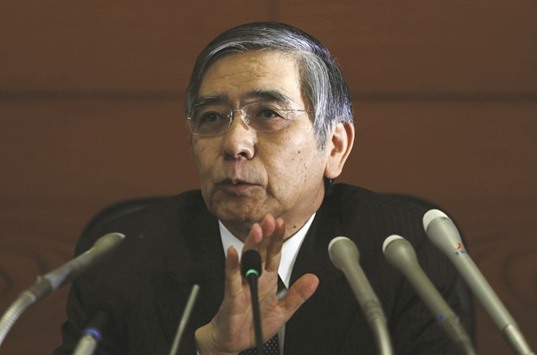The Bank of Japan continues to push the boundaries of monetary policy.
The BoJ surprised markets on Friday by joining the less-than-zero club of economies that have embraced a policy of negative interest rates, requiring financial institutions to pay the central bank to park some of their cash beyond required reserve levels. Once considered unthinkable among central bankers, the pay-to-save strategy has now been adopted in Sweden, Denmark, Switzerland, and by the European Central Bank, in a bid to get banks’ lending and companies spending. In the case of Japan, the bold move by Bank of Japan governor Haruhiko Kuroda shows the lengths that the BoJ is willing to go to end a decades-long economic malaise. Since taking over in 2013, Kuroda has already pushed monetary policy to the limits with an aggressive quantitative easing programme of bond and other asset purchases that has blown out the central bank’s balance sheet to about three-quarters the size of the economy. Along the way, the yen has tumbled more than 20% versus the dollar.
Kuroda’s adventures in extreme central banking were designed to lift Japan out of the deflationary mire and generate an inflation rate of 2%. Under Japanese Prime Minister Shinzo Abe’s three-pronged economic policy, dubbed Abenomics, the BoJ’s policies were to coincide with an aggressive fiscal expansion and tough-minded restructuring reforms to get the $4.6tn economy back on track.
The BoJ has done its part. Abe’s ruling-Liberal Democratic Party hasn’t kept up. An ill-timed tax hike in 2014 pushed Japan into recession. Inflation remains tepid – in fact, deflation remains a risk – exports are disappointing, consumer spending is weak and businesses aren’t investing enough. The world’s third-biggest economy grew at an annualised rate of 1% in the third quarter.
“Nothing is on track in Japan and that’s why the pressure was rising on the Bank of Japan,” said Klaus Baader, chief Asia-Pacific economist at Societe Generale in Hong Kong.
Officially called “Quantitative and Qualitative Monetary Easing (QQE) with a Negative Interest Rate,” the BoJ board agreed on Friday by a tight 5-4 vote to implement a rate of minus 0.1% on certain excess holdings of cash.
The announcement came just hours after government reports showed that economy was unexpectedly weak in December, with bigger-than-anticipated declines in industrial production and household spending. Japan’s Topix index was whipsawed after the BoJ decision with shares initially soaring 3.1%, before losing those gains, only to rally again and close 2.9% higher.
Analysts are mixed on how effective his latest manoeuver will be given it’s a potential negative for the nation’s banks.
“It’s unclear how much positive impact there’ll be on the actual economy, and the impact it’ll have on Corps and shares,” said Norihiro Fujito, general manager of Mitsubishi UFJ Morgan Stanley Securities Co in Tokyo. “The interest from current accounts held at the Bank of Japan was a source of income for financial institutions, but now they can’t bank on that.” Subdued credit demand shows the scale of the task ahead. A gauge of demand for home loans fell to -4 in January. While a measure of demand for corporate loans advanced to a two-year high, the level remains below those reached during Japan’s pre- global crisis expansion in 2006-07.
For an economy that’s been stagnant for two decades, what’s needed are deep, painful structural reforms led by the government, according to David Carbon, chief economist at DBS Bank in Singapore. “Monetary policy can’t shoulder the whole burden,” he said. “Negative rates to the tune of 10 basis points isn’t going to do much of anything.” That throws down the challenge to Abe who has advocated for reflationary policies that weakened the yen and boosted corporate profits. His goal is to expand Japan’s nominal GDP by 20% to ¥600tn over five years as part of a “three-arrow” strategy, borrowing the image from a Japanese folk tale that teaches that three together are harder to break than one.
The next phase of Abenomics is meant to tackle the nation’s demographic woes as the nation’s 127mn population is simultaneously ageing and shrinking. Abe’s plans suffered a setback when his economy minister, Akira Amari – a key engineer of Abenomics – resigned over a graft scandal last week.
A little more than a year from a planned sales-tax increase, a debate is deepening in the corridors of power in Tokyo over whether the economy can withstand the blow. The government also needs to consolidate support for the Trans-Pacific Partnership trade agreement that will bring greater access to foreign goods and services.
Since returning to office in December 2012 – Abe also served as prime minister in 2006-2007 – he has held the position longer than any of the past five leaders. Voter support remains relatively high, according to three polls conducted over the weekend, keeping Abe on course to consolidate power in an upper-house election expected in July.
Still, economists remain to be convinced that the fiscal authority will drive through its promised agenda, keeping pressure on Kuroda, said Marcel Thieliant, a Singapore-based economist for Capital Economics. “The Bank of Japan has to do the heavy lifting.” Kuroda, 71, will have a job convincing the markets he can succeed. The economic slowdown in China, Japan’s biggest trading partner, is a drag on growth. The negative rate policy takes effect Feb. 16 and will operate as three-tier system on financial institutions’ current accounts. “Will it make a huge difference? I have my doubts, but it shows that the BoJ isn’t just sitting back,” said Societe Generale’s Baader. “Symbolically, I think it is a much greater step than it is effectively.” An opinion poll published by the Yomiuri newspaper yesterday showed just 24% of respondents thought the BoJ’s move would help the economy, while 47% said it would not.
Twenty-eight per cent gave no answer.
The central bank on Friday also announced it’s delaying the timing of reaching the 2% price target to around the six months starting in April 2017, the third postponement in less than a year. The bank now sees inflation rising 0.8% in the 12 months starting this April, down from a previous forecast of 1.4%.
At a conference hosted by the BoJ last year, Kuroda cited Peter Pan for inspiration.
“I trust that many of you are familiar with the story of Peter Pan, in which it says, ‘the moment you doubt whether you can fly, you cease forever to be able to do it,” he said at the time.
For Kuroda, with subdued wage growth and falling oil prices, reaching his key inflation goal looks as far away as ever.

Kuroda: Trying to end a decades-long economic malaise.


